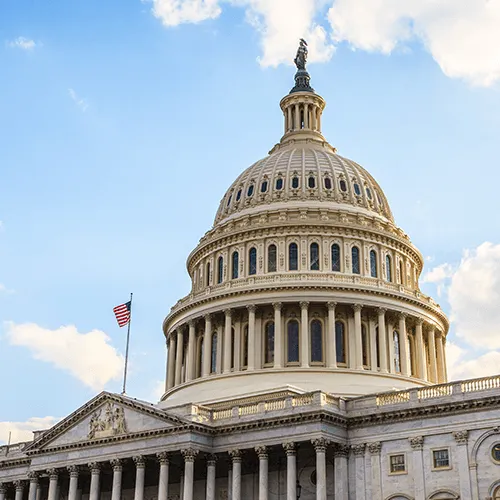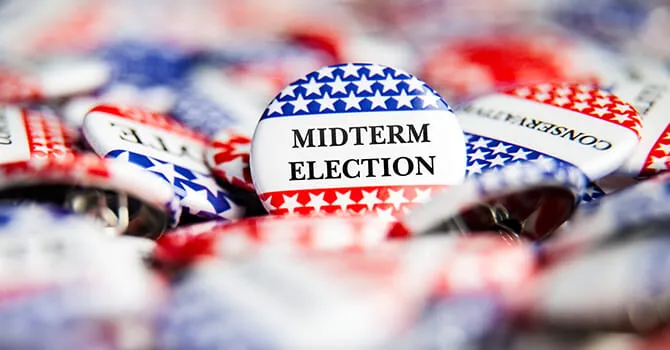
Fri, May 19, 2023
The Debt Ceiling—This Time is Different
The Debt Ceiling—This Time Is Different
The debt ceiling is a unique United States oddity1, but must be taken very seriously given its ability to disrupt markets and the economy. First established during World War I, the debt ceiling allows the Treasury Department to issue bonds to finance expenses without Congress approving each issuance separately, as had previously been the case. When the debt ceiling is hit, Congress generally agrees to lift it so that the U.S. government can continue to pay for spending that has already been legislated. But occasionally there is a standoff between the Republicans and Democrats in Congress on whether to lift it and what each side can extract from the other to do so. Given political divisions, we are facing the mother of all standoffs now. A number of different scenarios are possible, with the implications for the U.S. economy ranging from bad to dire. Depending on how long the situation lasts, how it is managed and how investors react, there is enormous uncertainty about the damage that might be wrought if the debt ceiling binds.
The Current Standoff
The amount of allowable outstanding U.S. federal debt is currently set at $31.4 trillion, which the U.S. hit on January 19, 2023. The Department of Treasury has been using a series of accounting maneuvers to continue paying its bills, so the debt limit has not yet been binding. Off the back of April’s tax receipts and government outlays, Treasury Secretary Janet Yellen wrote in a letter on May 1 to House Speaker Kevin McCarthy that the U.S. government may be unable to meet its obligations as soon as June 1. The Treasury’s timeline was reinforced by the nonpartisan Congressional Budget Office (CBO), which warned that the Treasury will run out of funds in early June.
That a so-called “X date”—when the debt ceiling binds—looms is no surprise, but it is now going to hit much sooner than previously expected. Assuming they had more time to negotiate, politicians had been discussing the debt ceiling without urgency. That has now changed, with negotiations between President Joe Biden and the four bipartisan leaders of the House and the Senate happening in earnest.
While the leaders of the two congressional chambers and the president agree the U.S. must not reach the X date without lifting the debt ceiling, it is unclear how this will happen. From the outset, Republicans have demanded severe spending cuts in exchange for raising the debt ceiling. On April 26, the House narrowly passed a budget bill—the Limit, Save, Grow Act of 2023—that would roll back many of President Biden’s policy initiatives. It would scrap student loan forgiveness and funding for the Internal Revenue Service to improve tax collection, while slashing discretionary government spending. In return, the legislation would raise the debt limit by $1.5 trillion or until March 31, 2024 (whichever hits first), kicking the debt ceiling can down the road by less than a year and necessitating another likely debt ceiling showdown in an election year, when the standoff could be even more pronounced.
There is zero chance that the proposed Republican legislation will pass in the Senate. The Biden administration rightly argues that the debt ceiling is not related to spending going forward; debt is issued to pay the bills for spending that has already happened. If Republicans don’t like the government’s tax and spending policies, the argument goes, they should address this in the annual budget negotiations. The Democrats favor raising taxes on the wealthy and boosting tax collection rather than sharply cutting spending. The only area of overlap between the two parties is that Social Security and Medicare are off the table in these discussions.
The more imminent X date could result in a small increase in the debt limit to push negotiations out until the end of the fiscal year on September 30. This would mean the debt ceiling talks and negotiations to prevent a government shutdown would run concurrently. The risk is that there would be a simultaneous default on a payment and government shutdown. But shifting the talks to the end of the fiscal year would align them with the annual budget period, which is when tax and spending policy should be discussed. It may therefore open up some opportunities for horse trading so both parties agree to lift the debt ceiling for a longer period of time.
Implications of Brinkmanship
The mildest scenario for the debt ceiling standoff is a resolution as soon as possible and before the X date binds. However, it will probably require significant additional brinkmanship to focus politicians’ minds, and that is not without consequences. Investors have recently started to worry about the debt ceiling, with yields on Treasuries with maturity dates around the X date increasing significantly. According to Bloomberg, the U.S. Treasury has recently sold one-month bills at the highest yield on record for this maturity. Credit default swap spreads (CDS)—the premiums to insure U.S. debt—have also risen substantially, suggesting investors are starting to price in the risk of a default.
In terms of the impact on borrowing costs and growth, there is some precedent from both 2011 and 2013, when Congress waited until the last minute to raise the debt ceiling. According to the Government Accountability Office (GAO), the political standoff over the debt limit raised the government’s borrowing costs by roughly $1.3 billion (bn) in 2011. This is small relative to the size of both the U.S. economy and federal budget, which suggests investors didn’t think it very likely that the debt limit would bind. When S&P downgraded the U.S. sovereign debt rating, the VIX (the volatility index on the S&P 500) jumped to its second highest level at the time (after the Global Financial Crisis) and corporate credit spreads (measured as the difference between high yield and investment grade corporate bonds) widened substantially. In the 2013 standoff, Federal Reserve economists estimated that rates on Treasuries due to mature around the X date rose by roughly 21-46 basis points and liquidity contracted. With major central banks hiking rates and shrinking their balance sheets, liquidity now is already tight.
Rising borrowing costs in fixed income markets could pull capital out of equity markets, causing the latter to fall. This would have a wealth effect, prompting businesses and consumers to pull back on spending. According to a recent study by the Council of Economic Advisors, the implications of brinkmanship could include the loss of 200,000 jobs and a drag on growth of 0.3 percentage points.
Clean Debt Limit Increase
A clean debt limit increase with few or no fiscal strings attached would be the least economically damaging way of ending the current standoff. History is a good guide for how this might work given the vast majority of the over 100 increases since World War II have been clean. After haggling for months, politicians usually come to agreement just in time before the X date binds and pass legislation to raise the debt limit without any major conditions. This allows Treasury to continue paying all its bills.
Under the best-case scenario, a clean debt limit increase this time would probably be large enough to cover expected spending into early 2025 to avoid having another debt limit standoff in the middle of the 2024 presidential election. If that happened, Treasury bill yields would rise for notes maturing just after the X date. There could also be a drop in equity markets leading up to the agreement. But once a clean debt limit deal is agreed, there would likely be no lasting implications for either the U.S. economy or financial markets.
Republicans Extract Their Proposed Budget Cuts
Another potential outcome would be for Democrats to agree to at least a portion of the House Republicans’ proposed budget cuts in order to raise the debt ceiling before the X date. It wouldn’t be the first time a debt ceiling increase has been tacked onto deficit reduction efforts. The most recent example of this is the 2011 Budget Control Act. In almost all cases where a debt limit increase was linked to deficit reduction measures, Congress has had to approve temporary increases in the debt limit to allow time for legislators to hammer out a deal without the immediate risk of default.
In this particular case, Democrats would have to agree to a large reduction in future spending cuts to balance the government’s budget over a 10-year horizon. There would be no tax increases to help achieve a balanced budget. According to Moody’s Analytics, the Limit, Save, Grow Act of 2023 would cut government expenditure by $4.5 trillion over the next decade. Discretionary spending for fiscal year 2024 would be set equal to that in 2022 and annual spending growth would be capped at 1% over the next 10 years. It seems likely that defense spending would be left untouched, in which case non-defense discretionary spending would fall to the lowest since the 1960s by fiscal year 2033. The legislation would reverse a number of the Biden administration’s policy initiatives—including tax breaks for green energy projects, student loan forgiveness and beefing up IRS resources to improve tax collection—and would impose conditions on income support programs such as Medicaid and the Supplemental Nutrition Assistance Program (SNAP).
Moody’s Analytics estimates that the Limit, Save, Grow Act would cut into short- and long-term growth relative to a clean increase in the debt ceiling. Real GDP growth would be 0.65 percentage points lower at the end of 2024, which would exacerbate the recession we are expecting later this year. The Republican legislation would increase unemployment by over a percentage point to 4.6% by year-end, whereas a clean increase in the debt ceiling would push up unemployment by 0.36 percentage points. There would be distributional consequences of the Republican legislation as well, as lower income households tend to benefit more from government income support programs. In this scenario, we would expect restructuring and bankruptcies to rise, and valuations would need to be revised down along with GDP and inflation forecasts.
Prioritization
If U.S. lawmakers are unable to agree to raise the debt ceiling before it is binding, then the U.S. will default on payments. Before the X date was moved forward to June, this seemed like the most likely scenario. Now that the X date is nigh, there is a chance—though by no means is it a foregone conclusion—legislators may agree on a short increase until the end of the fiscal year. As a result, the probability of the U.S. defaulting on a payment has fallen marginally but is still uncomfortably high at around 30%.
The Treasury Department devised a playbook in 2011 for how to respond if the U.S. defaults on a payment and the Biden administration is likely to dust this off and implement it if no deal is reached before the X date. Under this plan, interest payments on Treasury securities would be prioritized and maturing debt would be rolled over by auctioning new securities for the same amount (thereby not increasing the country’s debt burden). The U.S. would not default on its debt. Technically, this is possible as bond payments are handled by the Fedwire payment system while other government obligations are paid via a different computer system.
While avoiding a debt default could mitigate the impact on U.S. and global markets, it is not without problems. First, it would be politically toxic for the Biden administration to admit that it is paying off foreign bond investors while social security checks and teachers’ pay were being put on hold—particularly in the run-up to an election year. Second, there would inevitably be legal challenges. Given the legal uncertainty, bond investors would demand a much higher premium to hold U.S. debt and government borrowing costs would rise.
Once bondholders have been paid, it is unclear how all the other debt obligations would be prioritized. It seems likely that Treasury would delay all payments until it had enough cash to pay a full day’s obligations rather than picking and choosing who gets paid first. These other outlays would have to be cut by an average of 25% per month given the CBO expects roughly 25 cents of every dollar of non-interest outlays will be financed by borrowing this year. The cuts in federal spending would probably be even larger in July and August given tax revenues tend to be lower in these months.
The market response in this scenario is nearly impossible to predict given it is without precedent in the U.S. Investors might consider that the U.S. is defaulting on obligations because it won’t pay rather than because it can’t pay and might shrug off missed payments initially. Alternatively, the same logic could push investors to consider the U.S. political system so completely dysfunctional that they demand a much higher premium for buying U.S. debt, structurally increasing U.S. borrowing costs. Some research suggests that the unparalleled safety and liquidity of the U.S. Treasury market lowers the interest rate on government bonds (relative to that of other government bonds) by roughly 25 basis points. This adds up to over $750 bn over the next decade. Any loss of this advantage would result in substantial costs for the taxpayer.
How markets and the economy respond depends in part on how long it takes for the government to raise the debt ceiling and make everyone whole. Even if the debt ceiling were only briefly binding, there would probably be lasting implications. Investors would consider that they may not get paid what they are due when it is due and so would anticipate these disruptions every time the debt limit approaches. This would drive up the risk premium and U.S. government borrowing costs would be structurally higher. Household and business confidence would plummet and take some time to rebound. The market reaction could be severe, pushing an already fragile economy into recession.
In 2013, the Federal Reserve estimated that if the debt ceiling binds for one month, 10-year Treasury yields would rise by 80 basis points, stock prices would fall 30% and the value of the dollar would drop 10%. This would cause the U.S. to import inflationary pressures from abroad at a time when domestic inflation is already too high. According to analysis from the CEA, a short failure to pay obligations would wipe out half a million jobs, push up unemployment by 0.3% and eliminate 0.6 percentage points from GDP growth.
The implications would be much worse if the default lasted longer. The CEA estimates that a binding debt ceiling for a full quarter would send the stock market sinking by 45% while GDP would fall by 6.1 percentage points, 8.3 million jobs would be lost and unemployment would rise by 5 percentage points. According to Moody’s Analytics, a debt ceiling that binds for an extended period would shave 4 percentage points off of growth, eliminate 7 million jobs, push unemployment above 8%, send stocks falling by nearly 20% and cause all public and private sector bond yields to spike. These estimates differ, but they are all dire.
The Federal Reserve would cut interest rates in this scenario, but the Treasury department would be unable to provide countercyclical fiscal measures given its inability to borrow. On the contrary, it would have to slash its spending, making the recession even worse.
The U.S. could face additional credit ratings downgrades. Fitch has indicated that prioritizing debt payments to avoid an immediate default might not be consistent with a “AAA” rating. Countries that are stripped of their “AAA” status typically see their cost of funding go up. Business loans and other corporate debt instruments are typically priced as a spread over U.S Treasuries. An increase in the cost of funding for the U.S. government would place further upward pressure on the cost of debt faced by businesses, which for investment-grade companies already stands at similar levels to 2009. This scenario would see bankruptcies and restructuring rise and M&A activity would suffer significantly. Valuations would need to be revised down along with growth and inflation forecasts.
U.S. Defaults on Debt
If the Treasury decides not to prioritize debt payments or runs out of funds to do so when the debt ceiling binds, the U.S. would default on its debt. This would be catastrophic for U.S. and global markets as U.S. Treasuries are a global benchmark and the U.S. dollar is the global reserve currency. Investors would come to reasonably decide they cannot trust the U.S. to pay on its obligations. Borrowing costs would structurally rise for the U.S. to reflect a much higher risk premium. Investors could hedge by buying Credit Default Swap products, but given that global markets price off of benchmark Treasuries, there would be few markets in which to avoid this storm.
A debt default by the U.S. would probably trigger a crisis similar to 2008, when Congress initially failed to pass the Troubled Asset Relief Program (TARP) bailout of the banking system and the equity and credit markets plummeted. Congress passed TARP a few days later, though significant damage had already been done. Even a short-term U.S. debt default would likely have similar market effects as the TARP moment, and short-term funding markets would seize up.
Even with a quick turnaround to raise the debt ceiling, the macroeconomic, market and geopolitical implications of a U.S. debt default would be severe. Not only would borrowing costs be structurally higher, but investors might shift out of Treasuries and ultimately out of U.S. dollar assets altogether. While I don’t think the supremacy of the U.S. dollar as a global currency is at stake any time soon given the network effects of transacting in U.S. dollars, a reduction in the global use of dollars on the margin makes financial sanctions less effective as a tool for protecting U.S. national security.
Moreover, U.S. allies account for the majority of externally held U.S. Treasuries. Among the largest foreign U.S. Treasury holders are Japan, Taiwan, South Korea, India, Thailand and Vietnam. Stiffing these allies as geopolitical tensions rise could sow mistrust at an inopportune time.
Federal Reserve Steps In
At his latest press conference, Chair Jerome Powell insisted that the Fed is unlikely to be able to protect the U.S. economy from the damage prompted by a binding debt ceiling. However, this isn’t strictly true. The Fed could temporarily restart quantitative easing (QE) by buying Treasuries, as the Bank of England did last September when UK government bond yields spiked. If a default pushed short-term rates up, the Fed could expand its standing repo facility. If demand for un-defaulted government securities pushed their yields too low, the Fed could lend Treasuries to the market via reverse repos.
The central bank could also accept defaulted Treasuries as collateral or buy them outright, an option Chair Jay Powell called “loathsome” on a Fed conference call in 2013. Hoovering up defaulted securities would almost certainly be met with lawsuits and could increase inflation when it is still too high. The Fed will also be wary of creating moral hazard by bailing out politicians dithering on lifting the debt ceiling.
Unprecedented Measures
There are a few maneuvers that can technically be implemented to avoid missing any payments should Congress fail to raise the debt ceiling in time. Most have been deemed gimmicks by policymakers and others, and could come under legal challenges. And none seem appropriate for a country that issues the world’s benchmark risk-free asset. But it would be less shambolic for the U.S. to try to implement these than to default on its debt.
- Mint the Coin: Legislation was established in the 1990s to set the parameters for establishing collective coins. The law allows the Treasury Department to mint a platinum coin of denominations at the Treasury Secretary’s discretion. Treasury could in theory mint a platinum coin worth $1 trillion and deposit it with the Fed. The Fed would add $1 trillion to Treasury’s account at the Fed, and the government could draw on this account to pay its bills. One problem is that the Fed might not accept the deposit out of fear of being stuck in the middle of the debt ceiling battle and eventually losing its independence. Treasury Secretary Yellen has highlighted this concern.
Another common criticism of this option is that the Fed would essentially be creating money out of thin air, and so any spending would be inflationary. But this is not necessarily the case; if the Fed successfully sterilizes the transaction then it needn’t be inflationary. But the Fed would have to sterilize the operation by selling treasuries, which ultimately may not work if investors are concerned about the U.S. government’s ability to honor its debt obligations. This is therefore a risky strategy.
- Issue Premium Bonds: An alternative to minting a coin is to issue premium bonds, which is much more complicated to understand and therefore more likely as a solution. Effectively, the Treasury could issue debt with interest well above market rates. Bond yields and prices have an inverse relationship, and so the face value of the bonds would be lower. This would allow the Treasury to raise a substantial amount of money while adding relatively little to the debt stock. This is a financial engineering gimmick, and would be costly over the longer term as the Treasury commits to making higher and higher interest payments. Investors might see through this ploy and shun U.S. treasuries, anyway.
- Invoke the 14th Amendment: A final potential option to avoid missing payments is for the president to invoke Section 4 of the 14th Amendment of the Constitution, which states that the “validity of the public debt of the United States…shall not be questioned.” This provision was added to the Constitution following the Civil War to ensure the federal government was not going to be saddled with the war debt of the Confederate States. There would undoubtedly be legal challenges against using it in this context, and investors may perceive it as a desperate measure.
So far, the market reaction to a potentially binding debt ceiling has been perceptible but relatively muted. This will change as the X date approaches, and ultimately that may be a good thing. Politicians often posture until they face an emergency so dire that they have to make a decision. Market discipline will probably be necessary to prompt such an emergency. There are a number of scenarios that involve the U.S. avoiding a debt default. But even the political brinkmanship we are already witnessing on the debt ceiling will have macroeconomic and market impacts. A more imminent X date suggests that an agreement to raise the debt ceiling until the end of the fiscal year could be struck. This should provide opportunities for a real discussion about budget discipline, which otherwise would be inappropriate to attach to the debt ceiling. Even if a worst-case scenario is avoided, any drag on output in this environment of weak growth is unwelcome. If the X date binds, the implications for markets and for our clients will depend on which payments are missed and for how long. We are confident everyone will be made whole in the end, but the loss in confidence and wealth that could result if the U.S. defaults will have lasting effects on the economy.
Sources
1.Denmark also has a debt ceiling, but it has never been used in political brinkmanship.
Valuation Services
Objective valuations for financial reporting, tax and management planning purposes.
Compliance and Regulation
End-to-end governance, advisory and monitorship solutions to detect, mitigate and remediate security, legal, compliance and regulatory risk.
Corporate Finance and Restructuring
M&A advisory, restructuring and insolvency, debt advisory, strategic alternatives, transaction diligence and independent financial opinions.
Cyber and Data Resilience
Incident response, digital forensics, breach notification, security strategy, managed security services, discovery solutions, security transformation.
Investigations and Disputes
World-wide expert services and tech-enabled advisory through all stages of diligence, forensic investigation, litigation, disputes and testimony.






